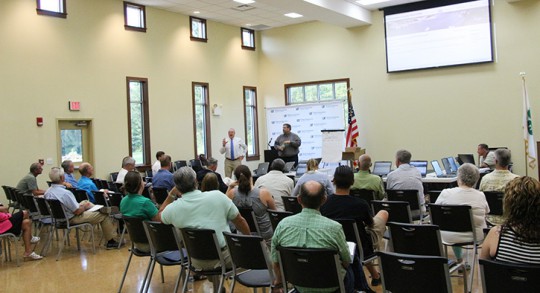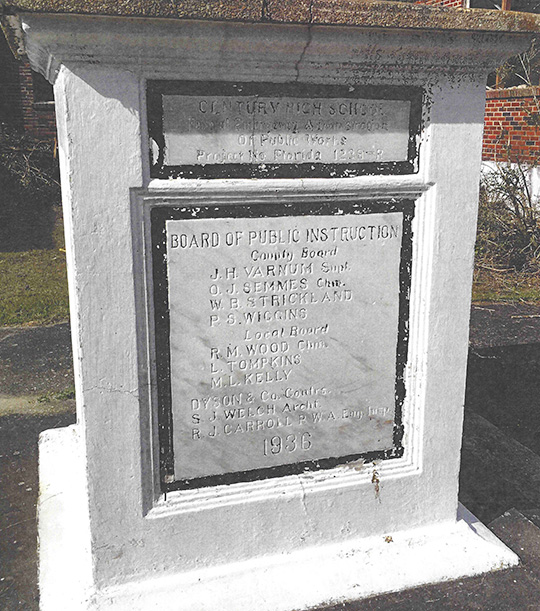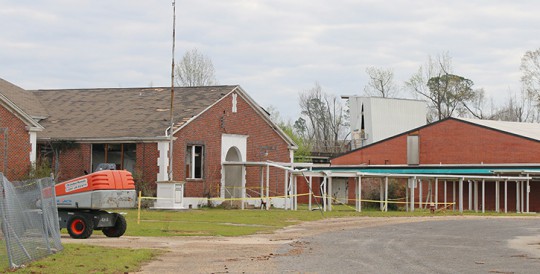Sunny Days, Clear Nights
April 7, 2016
Here is your official North Escambia area forecast:
Thursday Night: Clear, with a low around 53. Southwest wind 5 to 10 mph.
Friday: Sunny, with a high near 76. Northwest wind 5 to 10 mph.
Friday Night: Mostly clear, with a low around 45. Northwest wind around 5 mph.
Saturday: Sunny, with a high near 71. North wind around 5 mph.
Saturday Night: Mostly clear, with a low around 47. North wind around 5 mph becoming northeast after midnight.
Sunday: Mostly sunny, with a high near 72. East wind 5 to 10 mph becoming southeast in the afternoon.
Sunday Night: Mostly clear, with a low around 54. Southeast wind 5 to 10 mph.
Monday: Mostly sunny, with a high near 77.
Monday Night: A 40 percent chance of showers and thunderstorms. Mostly cloudy, with a low around 64.
Tuesday: A 30 percent chance of showers and thunderstorms. Mostly cloudy, with a high near 78.
Tuesday Night: A 20 percent chance of showers and thunderstorms. Mostly cloudy, with a low around 62.
Wednesday: A 40 percent chance of showers and thunderstorms. Mostly cloudy, with a high near 76.
It’s No Longer Illegal To ‘Shack Up’ In Florida
April 7, 2016
For the first time since shortly after the Civil War, it is no longer a crime for unmarried men and women to shack up in the Sunshine State.
 Gov. Rick Scott signed 20 bills into law Wednesday, including a long-discussed repeal of the state’s rarely enforced ban on unmarried men and women living together.
Gov. Rick Scott signed 20 bills into law Wednesday, including a long-discussed repeal of the state’s rarely enforced ban on unmarried men and women living together.
The repeal became law with Scott’s approval.
The signing (SB 498) leaves Michigan and Mississippi as the only states that make cohabitation illegal, according to a Senate analysis of the bill, which was approved during this year’s legislative session without opposition in the Senate and with only five dissenting votes in the House.
Rep. Richard Stark, a Weston Democrat who co-sponsored the repeal, argued on the House floor that the ban had impacted seniors as well as younger singles.
“I represent communities of seniors, where a lot of them are technically not married,” Stark said. “They are living together, but it makes more sense financially or for whatever reason like Social Security to not be married. I don’t think that they want to be considered to be violating the law.”
Opposing the repeal were Republicans Janet Adkins of Fernandina Beach, Brad Drake of Eucheeanna, Mike Hill of Pensacola Beach, Jennifer Sullivan of Mount Dora and Charles Van Zant of Keystone Heights.
A House staff analysis noted the cohabitation law has rarely been used to bring criminal charges, but it has been used in other ways. As an example, the analysis said the Florida Department of Business and Professional Regulation suspended a company’s liquor license in 1979 after finding that six people tied to the company were in violation of the law.
Enacted in 1868, the law declared it illegal for men and women to “lewdly and lasciviously associate and cohabit together” without being married. Violators could face second-degree misdemeanor charges.
The measure signed by Scott does not impact another part of state statute on lewd and lascivious behavior, maintaining the misdemeanor charge for men and women, married or unmarried, who engage in “open and gross lewdness.”
Among the other bills signed into law Wednesday was a wide-ranging measure (SB 698) that, in part, will allow the state Division of Alcoholic Beverages and Tobacco to issue alcoholic beverage licenses to the owners of railroad transit stations that are used for passenger service between two or more cities.
Another new law (SB 218) will make it a first-degree misdemeanor to have two or more electronic benefit transfer cards and to sell or attempt to sell one of the cards. A second offense would be a third-degree felony. The intent of the law, which goes on the books Oct. 1, is to crack down on the trafficking of EBT cards, which help provide food assistance to low-income Floridians.
Also, starting July 1, a new law (SB 1202) will require county and municipal parks to offer full or partial entry-fee discounts to current members of the military and honorably discharged veterans. Also, the discounts will apply to spouses and parents of members of the military who died in combat, and spouses and parents of emergency first responders who died in the line of duty.
by Jim Turner, The News Service of Florida
Career Academies, Students Honored
April 7, 2016
The school districts of Escambia and Santa Rosa counties recently recognized the best of their career academies and their students.
Career academies are small learning communities where students complete a rigorous program of study within a career pathway. The academies produce students ready for college and careers. With the guidance of teachers and business partners, students develop knowledge around a given industry while they are provided with opportunities to earn industry credentials relevant to their chosen career path and to participate in related work-based learning.
The following winners of outstanding business partners, students, teachers and academies categories were recognized at the Seventh Annual Career Academy Awards Luncheon:
Healthcare Industry Partner:
Arcadia Health and Rehabilitation Center – Mary Reid
Information Technology Industry Partner:
University of West Florida – Anthony Pinto
Agriscience Industry Partner:
Veterinary Emergency Referral Center – Dr. David Bordelon & Catheryn Grantham
Aviation Industry Partner:
Unmanned Safety Institute – Alex Mirot
Marketing and Entrepreneur Industry Partner:
University of West Florida, Freelance Photography – Sabrina McLaughlin
Middle School Career Academy Student of the Year:
Shaleyah Carter – Bellview Middle School, Information Technology Academy
Alexis King – Woodlawn Middle School, Microsoft IT Academy
Middle School Career Academy Teacher of the Year:
Jonathan Cordier – Woodham Middle School, Information Technology Academy
Martha Fricks – Gulf Breeze Middle School, CAPE
Middle School Career Academy of the Year:
Information Technology Academy, Bellview Middle School
Santa Rosa Medical Center IT Academy, Hobbs Middle School
High School Career Academy Student of the Year:
Gabby Gordon – Escambia High School, Digital Design Academy
Andrew “Chase” Durbin – Milton High School, Aviation and Manufacturing Academy
High School Career Academy Scholar of the Year:
Kiana Celestino – Escambia High School, Digital Design Academy
Mary Katherine Ashford – Pace High School, Pace HS Communication and Graphic Arts
High School Career Academy Intern of the year:
Mariah McMullen – West Florida High School, Multimedia Academy
Athena Crawford – Navarre High School, Navarre High School Construction Academy
High School Career Academy Teacher of the Year:
Amy Hendrix – B.T. Washington High School, Sports Medicine Academy
Celene Sessions – Pace High School, YEA Academy
High School Career Academy of the Year:
Multimedia Academy, West Florida High School of Advanced Technology
Biotechnology Academy, Pace High School
Final RESTORE Project Rankings Listed, North Escambia Projects Score Low
April 7, 2016
The Escambia County RESTORE Act Advisory Committee will present their rankings of all 124 RESTORE applications to the Escambia County Commission late today. Five project specifically benefiting some part of the North Escambia area general scored low in the rankings.
The rankings are the final recommendation for the allocation of component funds, ending three years of work by the committee.
The direct component funding, or pot one of RESTORE money, is just part of the approximately $70 million Escambia County is expected to receive over the next 16 years as part of the final settlement of the 2010 BP Deepwater Horizon Oil Spill in the Gulf of Mexico. Escambia will also be eligible to apply for other sources of oil spill funding.
Once the commission selects the projects to receive RESTORE direct component funding, the county will draft a Multi-Year Implementation Plan and initiate a 45-day public comment period. Public input will be reviewed and necessary updates will be made before the MYIP is submitted to the U.S. Treasury Department for final review and acceptance.
The top 15-ranked project from the committee were (listed in ranked order with total cost):
- Eleven Mile Creek Stream Restoration $12,929,908
- Forest Creek Apartment Complex Acquisition/Demolition & Jones Creek Floodplain Restoration Project $2,029,200
- Perdido Key Gulf of Mexico Public Access $1,648,000
- Carpenter Creek and Bayou Texar Economic and Environmental Revitalization Plan $2,440,000
- Perdido Key Gulf of Mexico Public Access $1,648,000
- Port Pensacola Maritime Infrastructure Berth 6 Restoration $3,750,000
- Project Universal Access (promotion of tourism and fishing) $3,350,000
- White Island Restoration $169,000
- 11 Mile Creek Basin $4,024,000
- Hollice T. Williams Park -Stormwater Management/Recreational Facilities Project $3,764,000
- Lake Charlene/BridleTrail $1,000,000
- OLF8 Commerce Park Improvements $19,037,790
- Woodlands -UWF Scenic Hills–St Luke’s Church Neighborhood Partnership Stream Restoration & Flood Protection $3,753,466
- Escambia Wood Treating Superfund Redevelopment Master Plan $500,000
-
Sanders Beach Park Addition / Beach Restoration $17,268,246
Five projects specifically benefiting some portion of the North Escambia area (north of Muscogee Road) were submitted. Those projects (listed with rank and total cost) were:
31. Town of Century Water Quality Improvements $486,000
70. Cantonment Community Center $2,000,000
90. Lambert Bridge Road $500,000
97. Cottage Hill Water Works Infrastructure Update and System Improvements $3,700,000
116. Cantonment Sportsplex $50,000
For the complete project listings:
- Click here to view the scored and ranked list of 124 RESTORE project applications.
- Click here to view the RESTORE project applications separated by category.
Pictured top: A RESTORE project information meeting held during October 2015 in Cantonment. NorthEscambia.com file photo, click to enlarge
Justices To Decide On Higher Taxes For Satellite TV Than Cable
April 7, 2016
The Florida Supreme Court on Wednesday waded into a constitutional fight about a higher state tax rate for satellite-television companies than for their cable TV competitors.
The Florida Department of Revenue and a cable industry group asked justices to overturn an appeals-court ruling last year that sided with satellite companies DirecTV and Dish Network. In a 2-1 decision, a panel of the 1st District Court of Appeal found that the differing tax rates were discriminatory and violated the Commerce Clause of the U.S. Constitution.
Supreme Court justices questioned attorneys on both sides Wednesday and, as is customary, did not indicate when they will rule. But along with affecting cable and satellite companies, the outcome of the case could have major financial ramifications for the state — in part because the appeals court raised the prospect of providing refunds to satellite companies.
Jonathan Williams, an attorney for the Department of Revenue, told justices that there is no evidence the Legislature intended to discriminate when it set the tax rates. The issue centers on the state’s communications-services tax.
“Florida’s communications-services tax does not discriminate against interstate commerce,” Williams said, alluding to the federal constitutional issue.
But the satellite industry argues that the difference in tax rates violates what is known as the “dormant” Commerce Clause. The industry, in a brief filed last year, described the tax difference as “economic protectionism” that benefits cable companies over satellite firms that generate their services out of state.
“We have a situation in which the signal difference between cable and satellite is where they perform this critical activity of assembling and distributing pay TV service,” satellite industry attorney Eric Shumsky told the Supreme Court on Wednesday.
(Disclosure: The News Service of Florida and the Florida Cable Telecommunications Association, an industry group that is a party in the case, have a partnership for the Capital Dateline Online news show.)
The communications-services tax dates to 2000 and is actually paid by customers, though cable and satellite companies collect the money and remit it. The state tax rate for cable services is 4.92 percent, while the rate for satellite services is 9.07 percent.
Cable customers also face local communications-services taxes that do not apply to satellite TV. A Department of Revenue brief in the case said those local tax rates are typically about 5 percent, though they vary.
Williams argued Wednesday that the combined state and local taxes ultimately create higher rates for the cable industry than for satellite providers.
“In every single year examined in this case, satellite providers enjoyed a tax advantage over the pay-TV competitor cable,” he said. “Plainly, satellite is not the victim of discrimination against interstate commerce in this case.”
But Shumsky drew a distinction between the state and local taxes, saying that cable companies use local rights of way for their equipment. He said Congress provided an exemption on local taxes to satellite companies.
“The reason it (Congress) gave is, this is national industry that does not use public rights of way,” Shumsky said.
by Jim Saunders, The News Service of Florida
NorthEscambia.com photo, click to enlarge.
Man Gets 30 Years For Child Sex Abuse
April 7, 2016
An Escambia County man has been sentenced to 30 years in station prison after pleading to child sexual abuse charges.
 Robert Whitehead, 29, entered a plea to lewd or lascivious molestation and battery of a child.
Robert Whitehead, 29, entered a plea to lewd or lascivious molestation and battery of a child.
The case involved an ongoing pattern of sexual abuse by Whitehead on a young child.
Escambia County Circuit Judge Gary Bergosh sentenced Whitehead to 30 years state prison. After his release from prison, Whitehead will be on lifetime sexual offender probation. Whitehead will be required to register as sexual predator and comply with all statutory requirements.
Tate High Drama To Present ‘The Bully Plays’
April 7, 2016
The Tate High School Drama Department will present “The Bully Plays” at 7:00 each night Friday and Saturday in the school cafetorium. Tickets will be sold in advance and at the door for $5..
 The Bully Plays was commissioned in response to the growing epidemic of bullying and the all-too-often tragic results. The anthology includes 10-minute plays that are touching, imaginative, powerful, uplifting and funny. A botched chemistry experiment creates a horde of homophobic teenage zombie bullies. Three dinosaurs at a museum surprise three bickering kids on a school outing. A bully is forced to confront his victim “on the other side.” A girl on an anti-bullying crusade must face her own bullying. High-school kids discuss the heartbreak of realizing they contributed to a classmate’s death by remaining bystanders. A mother and brother try to come to terms with the suicide of their “technicolor” son and brother.
The Bully Plays was commissioned in response to the growing epidemic of bullying and the all-too-often tragic results. The anthology includes 10-minute plays that are touching, imaginative, powerful, uplifting and funny. A botched chemistry experiment creates a horde of homophobic teenage zombie bullies. Three dinosaurs at a museum surprise three bickering kids on a school outing. A bully is forced to confront his victim “on the other side.” A girl on an anti-bullying crusade must face her own bullying. High-school kids discuss the heartbreak of realizing they contributed to a classmate’s death by remaining bystanders. A mother and brother try to come to terms with the suicide of their “technicolor” son and brother.
The trickle-down effect of bullying is explored in several plays, along with the dangers of cyber-bullying.
Photos for NorthEscambia.com, click to enlarge.
Food Stamp Recipients Face Work Requirement
April 7, 2016
About 300,000 Floridians who qualified for food stamps now face a work requirement that went into effect Jan. 1 — and the possibility of at least temporarily losing benefits if they don’t meet the guidelines.
As of the first of the year, able-bodied, childless adults ages 18 to 49 were required to work, get job training or volunteer 20 hours a week to receive food stamps through what is formally known as the Supplemental Nutrition Assistance Program. Otherwise, they’re limited to three months of food assistance in each 36-month period.
Similar requirements also took effect in 21 other states. Gov. Rick Scott’s administration pointed to job opportunities in the state, but Sen. Bill Montford, a Tallahassee Democrat who represents a massive swath of rural communities, said food-stamp beneficiaries can’t find work in some areas.
“Especially in North Florida, in these rural counties that I represent, they have not felt this economic revival that people talk about,” Montford said. “Unemployment is still high. The jobs are not there. … The needs the SNAP program meets, I would say the needs in these rural counties are just as great as they were in 2009.”
The work requirement dates back to a 1996 welfare overhaul, but the federal government waived it in 2009 during the economic recession. Now, after unemployment rates have dropped, states are resuming the use of the work requirement.
The left-leaning Center for Budget and Policy Priorities said 21 Florida counties have jobless rates high enough and sustained enough to qualify for an exemption from the work mandate from the federal government.
“A few Southeastern states are electing to re-implement the time limit statewide even though some or all of the state qualifies for a waiver,” the center reported last month, noting that 500,000 to 1 million people will lose their food stamps in 2016. “Arkansas, Florida, Mississippi and North Carolina will be particularly hard hit.”
Scott’s administration sees a brighter picture because of the economy, and people will be able to continue receiving food stamps if they meet the work requirements.
Department of Children and Families spokeswoman Michelle Glady said in an email that the state’s unemployment rate is at an eight-year low of 4.9 percent.
“No Floridian currently receiving benefits will lose their eligibility,” Glady said. “However, they must meet minimum federal requirements for work, volunteering or active job search activities.”
Department of Economic Opportunity spokeswoman Morgan McCord echoed Glady and also said the state is trying to help people meet the requirements.
“In every county around the state, Florida’s CareerSource centers are working to help beneficiaries meet those requirements,” McCord wrote in an email. “Since January 1, 2016, 106,129 people have been placed into new jobs by the state’s 24 CareerSource locations.”
But others, such as Montford, say the state is diverse, and economic conditions vary.
For instance, in the district of Sen. Dwight Bullard, D-Miami, people have been coming to his office for help after losing their food-stamp benefits. He said many are working, but their low-wage jobs don’t add up to 20 hours a week.
“They’re being penalized even though they’re trying, even though their effort is good,” Bullard said.
What’s more, tens of thousands of Floridians were sanctioned for not complying with the mandate in the first month.
“If you don’t comply, what will happen is that you will immediately be sanctioned and lose your food stamps, even though you haven’t yet used up your three-month time limit,” said Cindy Huddleston of Florida Legal Services.
In January, 67,982 Floridians were sanctioned for not meeting the work requirement, thereby losing their food stamps “for a minimum of one month or until they comply with the work requirement, whichever is longer,” according to a letter sent to beneficiaries by the state. For a second act of noncompliance, the penalty is the loss of benefits for at least three months.
“By the nature of the work requirements and the exemptions and exceptions to the work requirements, it’s really mostly affecting the most vulnerable people that don’t have any other social safety net in place,” said Liam McGivern of Legal Services of Greater Miami.
Food-stamp benefits are typically worth $150 to $170 per month. The potential loss of benefits does not apply to people who have children or disabilities or to seniors.
The Department of Children and Families could ask the federal government to waive the work mandate. But a budget bill passed during a special legislative session last June would require the department to get legislative authority before applying for such a waiver.
“I would certainly encourage DCF to approach the Legislature, get permission, and request another waiver,” Montford said.
Debra Susie, executive director of Florida Impact, which works to reduce hunger and poverty, said the group is also concerned about what will happen to food banks and other non-profits that were already stretched thin by the recession.
by Margie Menzel, The News Service of Florida
Effort Underway To Preserve Bricks From Former Century High School
April 7, 2016
After the announcement that the former Century High School will be demolished, local residents all calling for bricks and a campus monument to be saved to preserve Blackcat spirit.
Closed 20 years ago, the Century High Building was constructed in the middle 1930’s. It was damaged during the EF-3 tornado that hit Century February 15 and will be torn down by the Escambia County School District.
Century resident Ray Hammond is spearheading an effort to save the bricks to be sold, engraved and placed at some sort of monument to the school. Hammond and Mayor Freddie McCall have a few potential locations in mind…the front lawn of City Hall, the Nadine McCaw Park or Showalter Park.
Buck Showalter, whose name appears on Showalter Park, was the son of a long time principal at Century High School.
McCall said he will request the bricks and the monument from the Escambia County School District. The town will also form a committee to decide how to use the bricks and memorialize the old Century High School. For more information, contact Hammond at (850) 256-2014.
For an earlier story about plans to demolish the school, click here.
Pictured: A dedication monument dated 1936 outside the former Century High School. Pictured below: The present day condition of the building. NorthEscambia.com photo, click to enlarge.
Visiting Kentucky Team Downs Northview
April 7, 2016
Visiting Corbin, KY, defeated the Northview Chiefs Wednesday night 12-2.
After a one-run first inning, Corbin powered ahead 6-0 with a five run second inning. The Chiefs two runs came in the fourth inning, which ended with Northview at a 9-2 disadvantage.
The Chiefs will be home Friday night as they host Chipley at 5:00.











